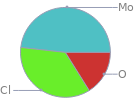Input interpretation

molybdenum(VI) dichloride dioxide | elemental composition
Result

Find the elemental composition for molybdenum(VI) dichloride dioxide in terms of the atom and mass percents: atom percent = N_i/N_atoms × 100% mass percent = (N_im_i)/m × 100% Plan: • Write the chemical formula and gather atomic masses from the periodic table. • Determine values for N_i, m_i, N_atoms and m using these items. • Finally, compute the percents and check the results. Write the chemical formula: MoO_2Cl_2 Use the chemical formula, MoO_2Cl_2, to count the number of atoms, N_i, for each element and find the total number of atoms, N_atoms: | number of atoms Cl (chlorine) | 2 Mo (molybdenum) | 1 O (oxygen) | 2 N_atoms = 2 + 1 + 2 = 5 Divide each N_i by N_atoms to calculate atom fractions. Then use the property that atom fractions must sum to one to check the work: | number of atoms | atom fraction Cl (chlorine) | 2 | 2/5 Mo (molybdenum) | 1 | 1/5 O (oxygen) | 2 | 2/5 Check: 2/5 + 1/5 + 2/5 = 1 Compute atom percents using the atom fractions: | number of atoms | atom percent Cl (chlorine) | 2 | 2/5 × 100% = 40.0% Mo (molybdenum) | 1 | 1/5 × 100% = 20.0% O (oxygen) | 2 | 2/5 × 100% = 40.0% Look up the atomic mass, m_i, in unified atomic mass units, u, for each element in the periodic table: | number of atoms | atom percent | atomic mass/u Cl (chlorine) | 2 | 40.0% | 35.45 Mo (molybdenum) | 1 | 20.0% | 95.95 O (oxygen) | 2 | 40.0% | 15.999 Multiply N_i by m_i to compute the mass for each element. Then sum those values to compute the molecular mass, m: | number of atoms | atom percent | atomic mass/u | mass/u Cl (chlorine) | 2 | 40.0% | 35.45 | 2 × 35.45 = 70.90 Mo (molybdenum) | 1 | 20.0% | 95.95 | 1 × 95.95 = 95.95 O (oxygen) | 2 | 40.0% | 15.999 | 2 × 15.999 = 31.998 m = 70.90 u + 95.95 u + 31.998 u = 198.848 u Divide the mass for each element by m to calculate mass fractions. Then use the property that mass fractions must sum to one to check the work: | number of atoms | atom percent | mass fraction Cl (chlorine) | 2 | 40.0% | 70.90/198.848 Mo (molybdenum) | 1 | 20.0% | 95.95/198.848 O (oxygen) | 2 | 40.0% | 31.998/198.848 Check: 70.90/198.848 + 95.95/198.848 + 31.998/198.848 = 1 Compute mass percents using the mass fractions: Answer: | | | number of atoms | atom percent | mass percent Cl (chlorine) | 2 | 40.0% | 70.90/198.848 × 100% = 35.66% Mo (molybdenum) | 1 | 20.0% | 95.95/198.848 × 100% = 48.25% O (oxygen) | 2 | 40.0% | 31.998/198.848 × 100% = 16.09%
Mass fraction pie chart

Mass fraction pie chart